
Welcome to KrabbeFacts
An educational site to bring you and your family quality information about Krabbe disease from trusted sources.
What is Krabbe disease?
Image ©2023 KrabbeConnect. Not for publication elsewhere.
Krabbe disease is a rare genetic condition affecting approximately 1 in 100,000 people in the United States. There are multiple types of Krabbe disease including Early Infantile, Late Infantile, Juvenile Onset, and Adult Onset. Each person with Krabbe disease is unique and experiences can differ.
We invite you to explore the site to learn more about Krabbe disease at your own pace. We’ve compiled information about the different ways Krabbe disease is diagnosed and treated, as well as the support resources available for families. While this is not meant to replace conversations with your doctors, we hope the information you find will help you feel comfortable starting and having those conversations. The information on this site is for educational purposes only and is not intended or implied as a substitute for professional medical advice, diagnosis, or treatment.
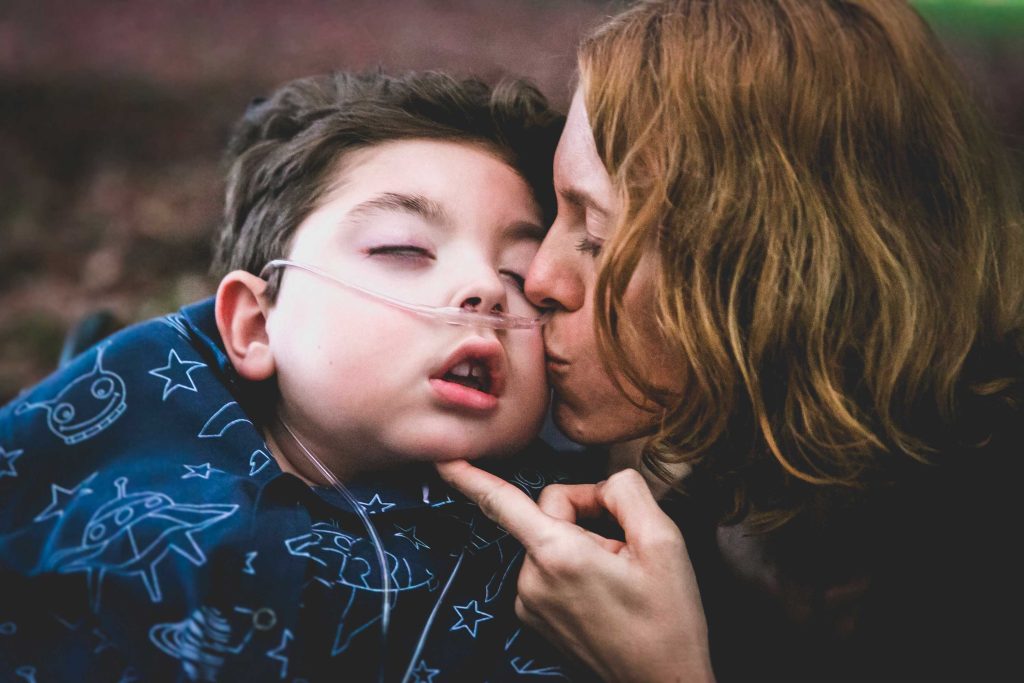
- Early Infantile Krabbe Disease: 0-12 months
- Late Infantile Krabbe Disease: 13-36 months
- Juvenile Onset of Krabbe Disease: 4-18 years
- Adult Onset of Krabbe Disease: 19 + years
Early Infantile Krabbe Disease (EIKD)
Image ©2023 KrabbeConnect. Not for publication elsewhere.
Onset of Symptoms: 0-12 months
Early Infantile Krabbe disease (referred to as EIKD) is the most common form with symptoms presenting right at birth up until 12 months of age. With EIKD, there’s a sense of urgency for the baby to undergo additional testing to assess if medical intervention is an option. The most common symptoms of EIKD are extreme irritability, difficulty eating, and loss of milestones (the child no longer can smile, coo, crawl, grasp for objects, or has abnormal muscle tone). Please see the most commonly asked questions below to help you quickly grasp the sense of urgency with this form of Krabbe disease.

What should I do after receiving a positive screen for Krabbe disease through Newborn Screening?
If your child received a positive screen for Krabbe disease, we strongly urge you to follow up with your pediatrician, a genetic counselor, or even a Krabbe disease expert right away. Further testing will likely be necessary to confirm a diagnosis, determine the stage of the disease and provide you with the best medical intervention options. Research has shown that intervention at the earliest point in Krabbe disease for those with the infantile form offers the best outcomes. It is vital that you work with your doctors with a sense of urgency to identify an option that works for you.
Why wasn’t my child identified on Newborn Screening?
Not all states screen for Krabbe disease at birth.
What is a Newborn Screening panel?
Newborn screening is a test done by the state on all babies shortly after they are born. This testing looks for signs of serious or fatal conditions that need to be found and treated quickly. To learn more about Newborn Screening and the conditions for which your state screens, we invite you to visit https://ldnbs.org/
What are my options for Early Infantile Krabbe disease?
The treatment options for EIKD are a HSC transplant (or HSCT), a clinical trial, or palliative and supportive care. If your baby is 12 months (1 year) old or younger and was diagnosed as a result of experiencing symptoms, your options will depend greatly on how quickly your baby was identified with EIKD. Oftentimes, babies identified through Newborn Screening are provided with additional options than babies diagnosed as a result of experiencing symptoms of the disease. The reason for this is that most symptomatic babies sustain irreversible brain damage at the time of diagnosis which disqualifies them as a candidate for more advanced interventions. However, we encourage you to have robust discussions with your healthcare team to discuss all options. If you are provided with palliative and supportive care as the best options, please know that the lifespan of children with EIKD who do not receive a HSCT or another intervention can vary greatly.
If I have another child, will they have Krabbe disease too?
Krabbe disease occurs when a child receives a non-working copy of the gene GALC from both their mother and their father. Parents are usually carriers, meaning they have one working and one non-working copy of the gene and do not show symptoms themselves. If both parents are carriers, there is a ¼ or 25% chance that each child that couple has would have Krabbe disease. For children who do not have Krabbe disease themselves, there is a ⅔ or 66% chance that the child would be a carrier for Krabbe disease like their parents and not be affected, and a ⅓ or 33% chance that they could be an unaffected non-carrier.
If a parent of a child with Krabbe disease has another child with a different partner, the chances that future children would have Krabbe disease or be carriers would depend on if their new partner is also a carrier for Krabbe disease. If their new partner is not a carrier for Krabbe disease, it is very unlikely that future children would have Krabbe disease. There would be a ½ or 50% chance that each child would be a carrier and likely not show any symptoms, and a 50% chance that each child would be an unaffected non-carrier.
Watch a video to learn how autosomal recessive diseases affect people.
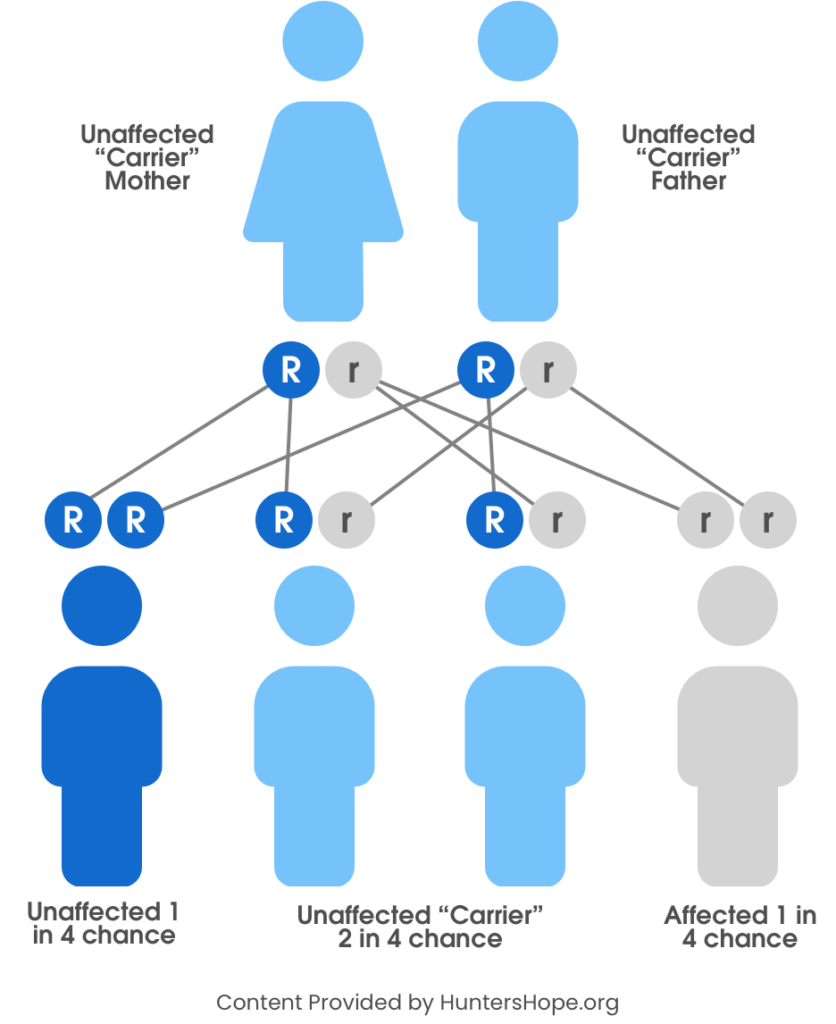
Late Infantile Krabbe Disease (LIKD)
Image ©2023 KrabbeConnect. Not for publication elsewhere.
Onset of Symptoms: 13-36 months
Experts categorize Late Infantile Krabbe disease (referred to as LIKD) as presenting between 13 and 36 months of age. Early symptoms of the disease vary more but some of the more common complaints are lack of interest in eating or can’t grab food to eat, increase in temper or irritability, sudden loss of vision, and just overall loss in important milestones (walking, talking, interacting with other children, grabbing objects, etc.). Children who fall in the LIKD category and are diagnosed as a result of experiencing symptoms must seek care immediately. Children diagnosed with LIKD as a result of newborn screening will likely be monitored closely by their doctors until an intervention is necessary. Please see the most commonly asked questions below to help you quickly navigate this form of Krabbe disease.
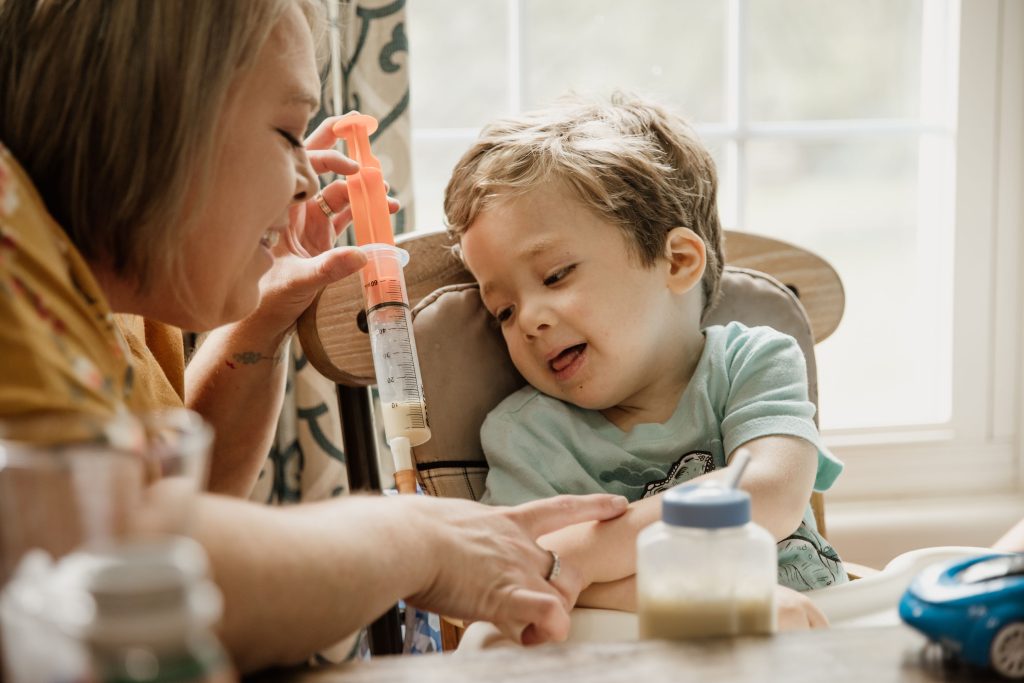
What should I do after receiving a positive screen for Krabbe disease through Newborn Screening?
If your child received a positive screen for Krabbe disease, we strongly urge you to follow up with your pediatrician, a genetic counselor, or even a Krabbe disease expert right away. Further testing will likely be necessary to confirm a diagnosis, determine the stage of the disease and provide you with the best medical intervention options.
Children with LIKD usually show symptoms of Krabbe disease at a much slower rate than children with the infantile form of Krabbe disease. For those with LIKD, being identified before disease symptoms are showing allows your healthcare team to properly monitor for the onset of disease and intervene only when tests suggest doing so. It also gives the opportunity for children to undergo treatment at the earliest point in the disease, allowing for the best possible outcome.
Why wasn’t my child identified on Newborn Screening?
Not all states screen for Krabbe disease at birth. Even if your state does currently screen for Krabbe disease, this might have been added after your child was born.
What is a Newborn Screening panel?
Newborn screening is a test done by the state on all babies shortly after they are born. This testing looks for signs of serious or fatal conditions that need to be found and treated quickly. To learn more about Newborn Screening and the conditions for which your state screens, we invite you to visit https://ldnbs.org/
What are the options for Late Infantile Krabbe disease?
The treatment options for LIKD are a HSC transplant (or HSCT), a clinical trial, or palliative and supportive care. If your child is between 13 and 36 months of age and was diagnosed as a result of experiencing Krabbe disease symptoms, options available for your family will likely vary depending on the stage of Krabbe disease when diagnosed, what country you currently reside in, and your personal beliefs on quality of life. We encourage you to have robust discussions with your healthcare team to discuss all options. If you are provided with palliative and supportive care as the best options, please know that the lifespan of children with LIKD who do not receive a HSCT or another intervention can vary greatly.
If I have another child, will they have Krabbe disease too?
Krabbe disease occurs when a child receives a non-working copy of the gene GALC from both their mother and their father. Parents are usually carriers, meaning they have one working and one non-working copy of the gene and do not show symptoms themselves. If both parents are carriers, there is a ¼ or 25% chance that each child that couple has would have Krabbe disease. For children who do not have Krabbe disease themselves, there is a ⅔ or 66% chance that the child would be a carrier for Krabbe disease like their parents and not be affected, and a ⅓ or 33% chance that they could be an unaffected non-carrier.
If a parent of a child with Krabbe disease has another child with a different partner, the chances that future children would have Krabbe disease or be carriers would depend on if their new partner is also a carrier for Krabbe disease. If their new partner is not a carrier for Krabbe disease, it is very unlikely that future children would have Krabbe disease. There would be a ½ or 50% chance that each child would be a carrier and likely not show any symptoms, and a 50% chance that each child would be an unaffected non-carrier.
Watch a video to learn how autosomal recessive diseases affect people.

Juvenile Onset of Krabbe Disease (JOKD)
Image ©2023 KrabbeConnect. Not for publication elsewhere.
Onset of Symptoms: 4-18 years
Juvenile Onset Krabbe disease (referred to as JOKD) is when children with Krabbe disease start to show symptoms between 4 to 18 years old. The onset of symptoms can present quickly or slowly over time. The common clinical symptoms of JOKD are seen as a loss in fine-motor skills, frequent trips, stumps, or just general walking difficulties, trouble remembering names or simple words, and complaints often about a burning or tingling sensation in extremities (peripheral neuropathy). Please see the most commonly asked questions below to help you quickly navigate this form of Krabbe disease.
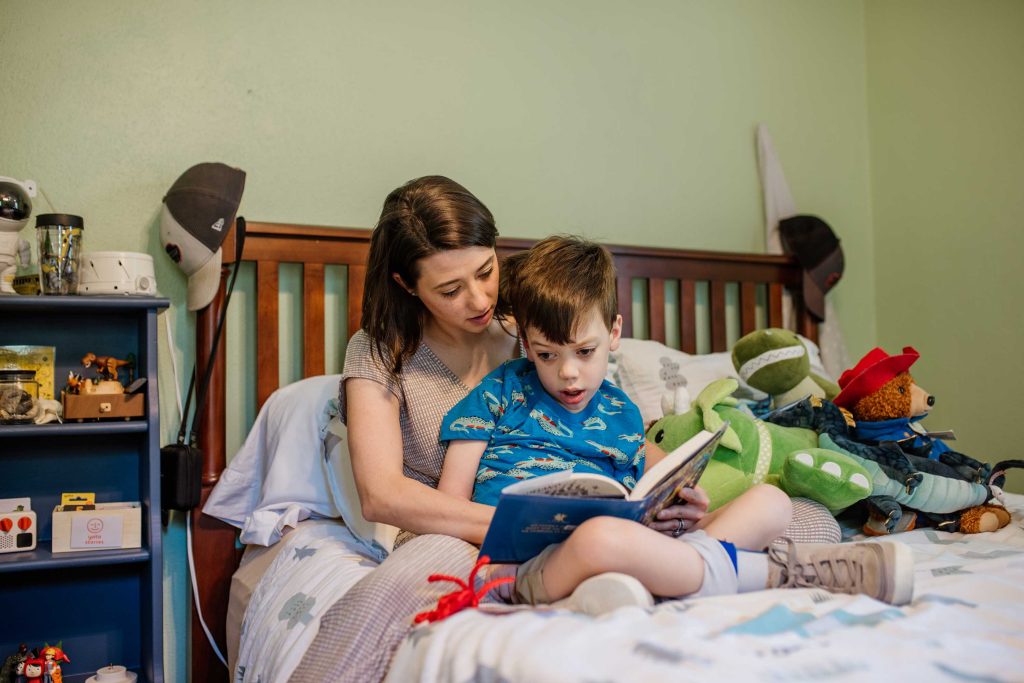
What should I do after receiving a positive screen for Krabbe disease through Newborn Screening?
If your child received a positive screen for Krabbe disease, we strongly urge you to follow up with your pediatrician, a genetic counselor, or even a Krabbe disease expert right away. Further testing will likely be necessary to confirm a diagnosis, determine the stage of the disease and provide you with the best medical intervention options.
Children with JOKD usually show symptoms of Krabbe disease at a much slower rate than children with the infantile form of Krabbe disease. For those with JOKD, being identified before disease symptoms are showing allows your healthcare team to properly monitor for the onset of disease and intervene only when tests suggest doing so. It also gives the opportunity for children to undergo treatment at the earliest point in the disease, allowing for the best possible outcome.
Why wasn’t my child identified on Newborn Screening?
Not all states screen for Krabbe disease at birth. Even if your state does currently screen for Krabbe disease, this might have been added after your child was born.
What is a Newborn Screening panel?
Newborn screening is a test done by the state on all babies shortly after they are born. This testing looks for signs of serious or fatal conditions that need to be found and treated quickly. To learn more about Newborn Screening and the conditions for which your state screens, we invite you to visit https://ldnbs.org/
What are the options for Juvenile Onset Krabbe disease?
The only treatment option at this time for JOKD is a “HSC transplant (or HSCT) however; your options could vary if you reside outside of the United States.
If your child is between 4 and 18 years of age and was diagnosed as a result of experiencing Krabbe disease symptoms, medical intervention will depend on the stage of disease at the time of diagnosis and how you feel about the information being offered (the risks, side effects, and potential outcomes or quality of life). We encourage you to have robust discussions with your doctors to discuss all options.
If I have another child, will they have Krabbe disease too?
If a parent of a child with Krabbe disease has another child with a different partner, the chances that future children would have Krabbe disease or be carriers would depend on if their new partner is also a carrier for Krabbe disease. If their new partner is not a carrier for Krabbe disease, it is very unlikely that future children would have Krabbe disease. There would be a ½ or 50% chance that each child would be a carrier and likely not show any symptoms, and a 50% chance that each child would be an unaffected non-carrier.
Watch a video to learn how autosomal recessive diseases affect people.

Adult Onset of Krabbe Disease (AOKD)
Onset of Symptoms: 19 + years
Adult Onset Krabbe disease (referred to as AOKD) is described as presenting in adults aged 19 and older. The onset of symptoms usually progresses slowly over time. In fact, many adults are often misdiagnosed or experience symptoms for a long time without a formal diagnosis. The common clinical symptoms are similar to that of JOKD. Those include losses in fine-motor skills, tripping, shuffling of feet, or just general walking difficulties, trouble remembering names or simple words, and feeling a burning or tingling sensation in extremities (peripheral neuropathy). Please see the most commonly asked questions below to help you quickly navigate this form of Krabbe disease.
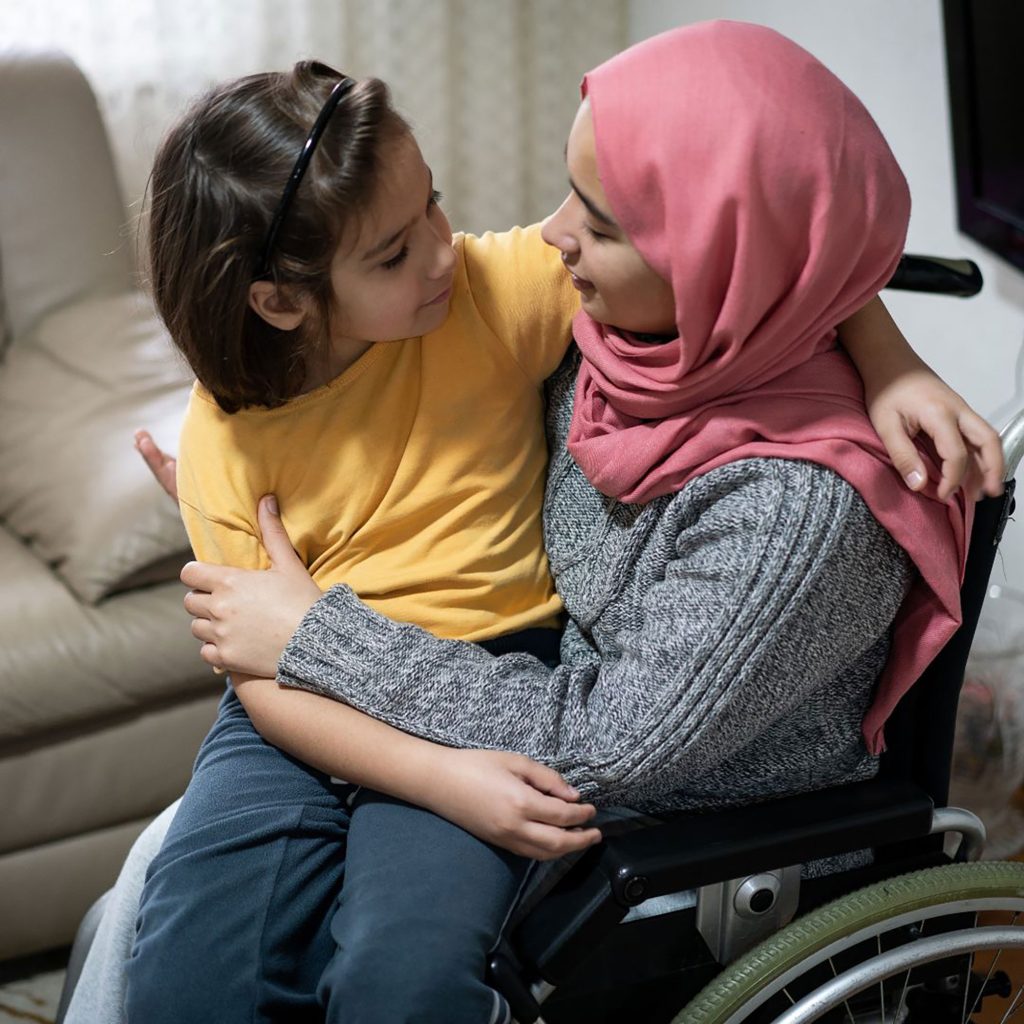
What is my option for Adult Onset Krabbe disease?
If you are 19 years of age or older and diagnosed as a result of experiencing Krabbe disease symptoms, medical intervention will depend on the stage of disease at the time of diagnosis, your current age, your current health, as well as how you feel about the information being offered (the risks, side effects, and potential outcomes or quality of life). The only intervention option at this time for AOKD is a HSC transplant (or HSCT), however, your options could vary if you reside outside of the United States. We encourage you to have robust discussions with your healthcare team to discuss all options.
If I have Krabbe disease, can I pass it down to my children?
Krabbe disease occurs when a child receives a non-working copy of the gene GALC from both their mother and their father. If you have Krabbe disease, that means that both of your copies of GALC are not working the way that they should. Each child that you have will inherit one of these non-working genes. The chances that your child would be affected with Krabbe disease depends on if your reproductive partner has Krabbe disease or is a carrier for Krabbe disease.
- If they also have Krabbe disease, it is expected that all of your children would also have Krabbe disease.
- If they are a carrier, meaning they have one working and one non-working copy of GALC, there would be a ½ or 50% chance that each child would have Krabbe disease, and a ½ or 50% chance that they would be a carrier and likely not have any symptoms of Krabbe disease.
- If your partner is not a carrier for Krabbe disease, it is expected that 100% of your children would be carriers for Krabbe disease and likely not show any signs or symptoms themselves.
Time-Sensitive Information to Consider

Image ©2023 KrabbeConnect. Not for publication elsewhere.
You are probably receiving a lot of information about your Krabbe disease diagnosis. Specific interventions for patients is time-sensitive and in some cases, needs immediate attention. HSC transplant (or HSCT) has been shown to improve outcomes for patients diagnosed with Krabbe disease.
There are also a number of clinical trials that the patient may be eligible for which can be found at U.S. National Library of Medicine trial resource site where you can search by disease name or other related terms. Some recent studies include:
- Krabbe Disease Global Patient Registry
- REKLAIM – For Infantile and Late Infantile Krabbe Disease
- RESKUE – For Krabbe Disease
Please talk with your doctor, or Krabbe disease expert, or connect with our advocacy groups to learn what options are available for you or your loved one.
Patient Journey
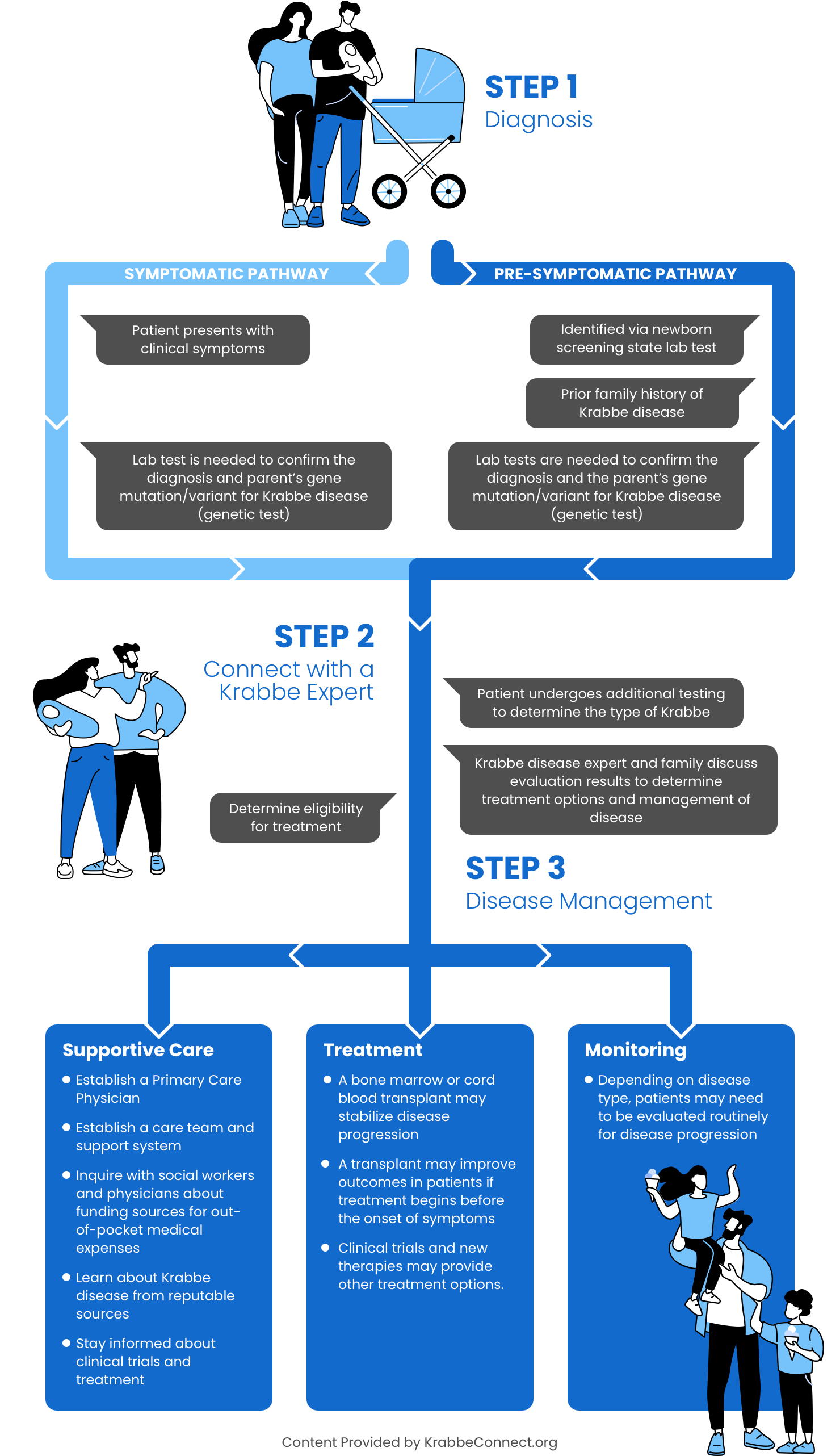
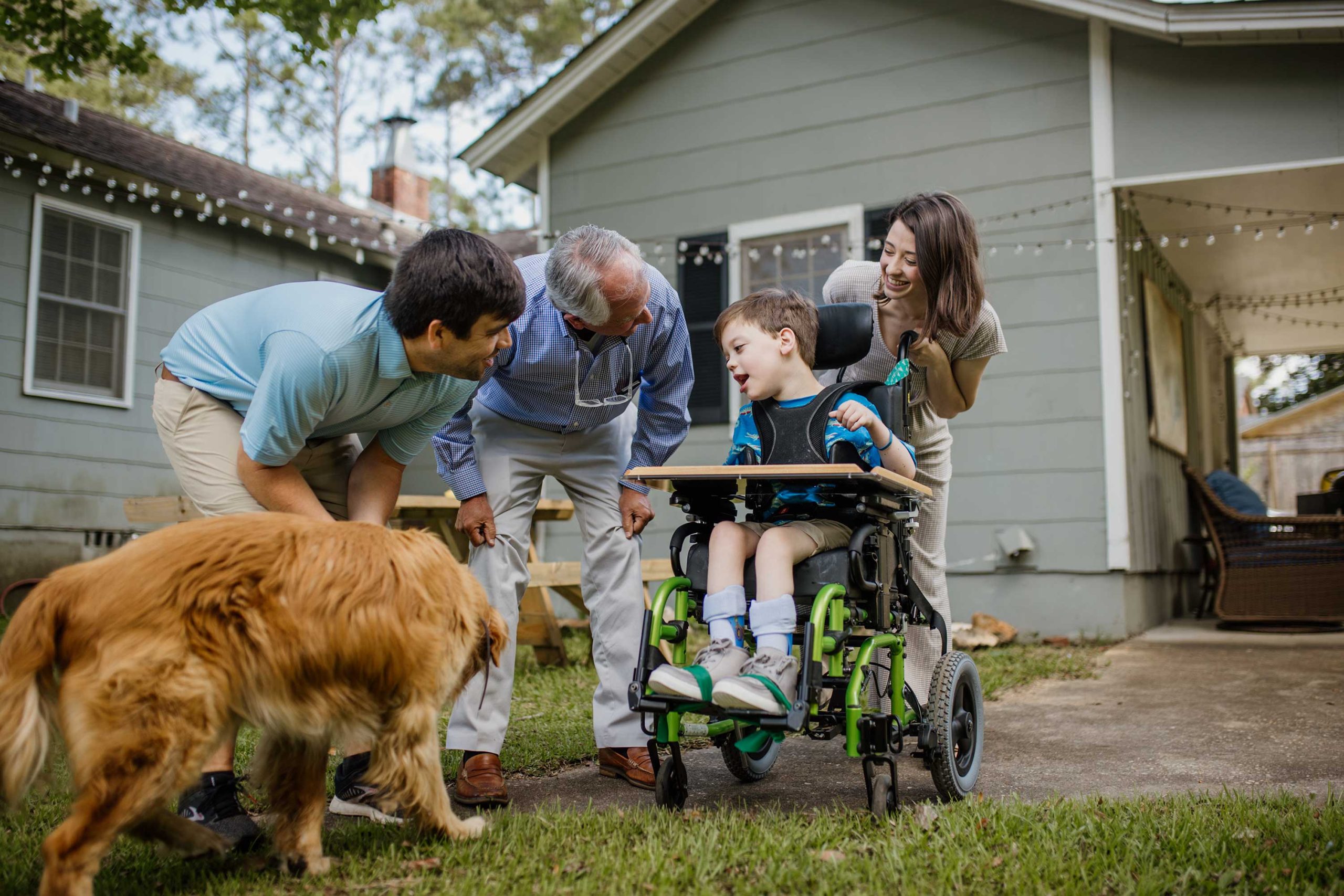
Image ©2023 KrabbeConnect. Not for publication elsewhere.
Frequently Asked Questions
How do you pronounce Krabbe disease?
You can pronounce “Krabbe” in different ways. Some pronounce the word as crab-A and others will pronounce it as KRAH-buh but in both instances, the word is pronounced in two syllables.
What is Krabbe disease?
Krabbe disease is a genetic condition that affects the nervous system. There are four main types of Krabbe disease used to describe when symptoms start to appear and how quickly they progress. The most common and severe form of Krabbe disease is the early infantile onset type (EIKD).
What is a genetic condition?
A genetic condition occurs when there is a change in a gene or instruction the body uses to make something it needs, which causes the product it makes not to work the way that it should. People can either inherit these changes from one or both parents, or it can be a new change that happened when a baby was being made. Genetic conditions are also sometimes called hereditary conditions.
What does it mean that Krabbe disease is an autosomal recessive condition?
People have two copies of most of their genes, one that they inherit from their mother and one from their father. Autosomal recessive conditions happen when there are changes in both copies of a gene. People with changes in one copy of the gene are called carriers, and usually do not have symptoms of Krabbe disease. If both parents are carriers for Krabbe disease, there is a ¼, or 25% chance, that each child they have would have Krabbe disease.
What does it mean to be a carrier of Krabbe disease?
A carrier for Krabbe disease is someone who has one working and one non-working copy of the gene that causes Krabbe disease (GALC). Carriers for Krabbe disease usually do not have any signs or symptoms of Krabbe disease themselves. It is important to know that most people are carriers for one or more genetic conditions, and carriers did not do anything to cause their child to have Krabbe disease. Researchers think that about 1 in every 125-150 people is a carrier for Krabbe disease.
How could my child have Krabbe if nobody in my family has ever had it before?
Most children with Krabbe disease do not have any known family history of the condition (unless they have an older brother or sister already diagnosed). Since Krabbe disease is an autosomal recessive condition, usually both parents have to be carriers for Krabbe disease for a child to be affected. Even if both parents are carriers, not every one of their children would have Krabbe disease. Other people in a family could have been carriers for many generations without having any affected children.
What is a Center of Excellence?
The phrase “Center of Excellence” indicates expertise in a specific condition and can help patients easily identify where they can receive the necessary assistance. Hunter’s Hope Foundation has created the Leukodystrophy Care Network (LCN) and there are currently centers across the United States to assist Leukodystrophy families with finding proper care. Read more here: https://www.huntershope.org/family-care/about-the-lcn/
What is palliative care?
Palliative care is specialized medical care for people with serious conditions aimed at improving the quality of life for both patients and their families. It is important to note that palliative care can be helpful for families at any stage of a serious condition, not only when someone is dying. This is different from hospice care. To learn more about palliative care, visit https://getpalliativecare.org/.
What is a clinical trial?
A clinical trial is a type of research study. To learn more about clinical trials, visit https://clinicaltrials.gov/ct2/about-studies/learn.
Say What? Terms You May Have Seen
You’ve probably seen a lot of words or abbreviations in your family’s records. Here are some common words, tests, or abbreviations you may have seen during a workup for Krabbe.
Image ©2023 KrabbeConnect. Not for publication elsewhere.
Who are the trusted sources that compiled this educational information?
Too often families struggle to navigate through a diagnosis of Krabbe disease and find appropriate information to make critical life decisions for their loved ones. Luckily, the strength of many has come together to help provide an introduction to Krabbe disease and a jumping point to continue learning more.
The following organizations are members who can provide additional information and direct services. We encourage you to learn more about their connection with families affected by Krabbe disease.

Hunter’s Hope Foundation was established to address the acute need for information and research with respect to Krabbe Disease and related Leukodystrophies. In addition, our mission is to strive to support and encourage those afflicted and their families as they struggle to endure, adjust and cope with the demands of these fatal illnesses. Learn More

KrabbeConnect’s mission is to be the source of comprehensive information and access to resources for patients with Krabbe disease. The foundation drives state-of-the-art research by bridging the gap between science and patient knowledge. Learn More
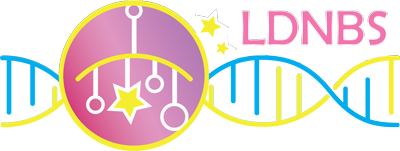
The Leukodystrophy Newborn Screening Action Network is dedicated to advancing newborn screening for leukodystrophies and lysosomal storage disorders, supporting newly-diagnosed families, and encouraging collaboration, coordinating efforts, and removing barriers between industry, advocacy groups, and parent advocates. Learn More

Other Resources to Explore
In addition to our committee stakeholder listed above, we’ve compiled a list of a sample of resources that may be helpful. Additional resources may be available based on other factors like where you live. We’d encourage you to reach out to your doctor as well. Often, hospitals have dedicated resource coordinators who can help you find local resources. Individual partner organizations may also have resources available listed on their own websites.
Other Krabbe Disease Resources:
- “Krabbe Disease (GLD)” – Be The Match Patient Support Center
- “Krabbe Newborn Screening – A Family Guide” – Hunter’s Hope
Other Helpful Resources:
- “Caregiver Support” – Genetic and Rare Disease Information Center
- “Compassionate Allowances Information” – Social Security Administration
- “Crisis Counselor” – Crisis Text Line
- “Genetic, Rare, and Orphan Disease Resources Online” – Genome.gov
- “Network of families and friends of children and youth with special health care needs and disabilities” – Family Voices
- “One-on-one Patient Support” – Be the Match Patients Support Center
- “Parenting a Child with a life-limiting illness” – Global Genes
- “Partnering with Doctor: The Me dical Home Approach” – Midwest Genetics Collaborative
- “Patient and Caregiver Resources Center” – National Organization for Rare Disorders (NORD)
- “Resources for Leukodystrophy Newborn Screening Advocacy” – Leukodystrophy Newborn Screening Action Network
- “The Circle of Care Guidebook for Caregivers of Children With Rare and Serious Illnesses” – NAC and Global Genes
Collaborators
The KrabbeFacts.org project is an education-focused collaboration initiated by KrabbeConnect. The Leukodystrophy Newborn Screening Action Network is a proud partner and collaborator since this website launched in April 2023.
The information on this site is for educational purposes only and is not intended or implied as a substitute for professional healthcare advice, diagnosis, or treatment. All content, including text, graphics, images, and information, contained on or available through this website is for general information purposes only. The krabbefacts.org site information is endorsed by the Krabbe Disease Stakeholder Committee. The Krabbe Disease Stakeholder Committee is a group of patient and advocacy organizations, sponsored by biopharma companies, that aim to provide accurate, helpful education and resources to Krabbe-affected families in the United States.



